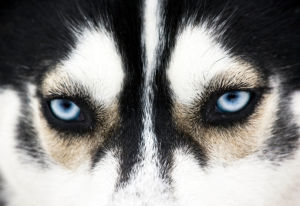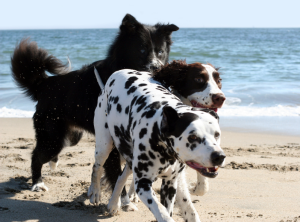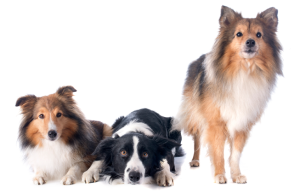 If there is one subject that has been beat to death in the dog world, it’s certainly the notion of pack hierarchy in dogs! For the longest time everything was about leadership. Most dog behavior problems were interpreted as a dominance issue and the way to treat them was to redeem our leadership status over our misbehaved pet. ‘Show him who’s boss!’ was a typical answer to Fido’s barking, destruction, elimination issues, biting, jumping, etc. This oversimplified understanding of canine psychology now gave place to a more comprehensive approach based on advances in scientific studies of our canine companions. Behavior problems are mostly interpreted in terms of stress, anxiety, fear and conditioning versus the dog’s desire to ‘dominate’ their human. But does that mean that dogs don’t have a social structure at all? Should we completely discard the idea that some individuals acquire a dominant position over others? Still a controversial subject, research today is exploring how social structure may influence how individuals influence one another. A new study shows that certain personality traits are indeed linked to leader and follower roles when the group is out on a walk.
If there is one subject that has been beat to death in the dog world, it’s certainly the notion of pack hierarchy in dogs! For the longest time everything was about leadership. Most dog behavior problems were interpreted as a dominance issue and the way to treat them was to redeem our leadership status over our misbehaved pet. ‘Show him who’s boss!’ was a typical answer to Fido’s barking, destruction, elimination issues, biting, jumping, etc. This oversimplified understanding of canine psychology now gave place to a more comprehensive approach based on advances in scientific studies of our canine companions. Behavior problems are mostly interpreted in terms of stress, anxiety, fear and conditioning versus the dog’s desire to ‘dominate’ their human. But does that mean that dogs don’t have a social structure at all? Should we completely discard the idea that some individuals acquire a dominant position over others? Still a controversial subject, research today is exploring how social structure may influence how individuals influence one another. A new study shows that certain personality traits are indeed linked to leader and follower roles when the group is out on a walk.
For any group to be able to live together without constant conflicts, its members have to be able to coordinate their efforts towards common goals. Unless individuals are able to collaborate with others and agree on where to go for instance, being part of a group could turn out to be more problematic than beneficial. Many animals live in social groups and amongst those groups, certain individuals bear more influence on the decisions of the many than others. When the leader moves in one direction, the others are likely to follow. Group leaders amongst species have been identified as having bolder personalities with a tendency to enforce their will on others more often. Sometimes leadership has nothing to do with social dominance and leaders simply have more skills than others. More research is needed on the subject, but it’s quite possible that certain personality traits are closely linked to an animal’s social status and influence on the rest of the group.
 With dogs, it’s often assumed that since they share most of their DNA with wolves, it’s likely that their social behaviors would be quite similar. In wolves, since most of them consist of a family, the breeding couple tends to lead more often than the others and initiates most of the traveling of the group. But social dynamics in wolves turn out to be much more complex and than we first thought. It seems that the breeding pair divides the chores, like a division of labor type system. The female will lead when it comes to taking care of the pups, and the male will initiate most of the movements of the pack. However, even during these movements, many subordinate individuals sometimes lead the group too (Peterson & al., 2002). The larger the group, the more fluid the structure and differences in age, alliances between the members of the pack as well as temperament will influence the social structure.
With dogs, it’s often assumed that since they share most of their DNA with wolves, it’s likely that their social behaviors would be quite similar. In wolves, since most of them consist of a family, the breeding couple tends to lead more often than the others and initiates most of the traveling of the group. But social dynamics in wolves turn out to be much more complex and than we first thought. It seems that the breeding pair divides the chores, like a division of labor type system. The female will lead when it comes to taking care of the pups, and the male will initiate most of the movements of the pack. However, even during these movements, many subordinate individuals sometimes lead the group too (Peterson & al., 2002). The larger the group, the more fluid the structure and differences in age, alliances between the members of the pack as well as temperament will influence the social structure.
We also need to be careful in the way we talk about dominance. Dominance isn’t a personality trait. The term defines a position towards another animal. It’s also never a set position. An animal can dominate one individual but show submission to another. That same animal may also act as a follower at times, even towards those that he has ‘dominated’. In wolves, when the breeding couple displays aggression towards the other members of the group, instead of dominance, it could have more to do with making sure those who breed get most of the food. That doesn’t mean that there is a linear hierarchical system (Mech, 1999). Instead of describing certain animals as ‘dominant’, it would be more accurate to talk about animals willing to impose their will on others to get what they need or want. When people use intimidation, yelling or physical force, to get what they want, we don’t generally qualify them as ‘dominant’, even though some may be in a supervisory position at work. The same behavior in others may label them as bullies with potential punishment from society. In both wolves and dogs, it’s still unclear whether there is a definite link between ‘dominance’ and leadership.
 A research team from the University of Oxford, along with colleagues from the Hungarian Academy of Science in Budapest (Ákos, 2014) wanted to investigate whether in dogs, just as in wolves, certain individuals tend to lead more often than others, and if this was linked with certain personality traits. In wolves for instance, those described most often as ‘dominant’, were also qualified as bolder with more tendencies to explore than others. 6 dogs (5 Hungarian Vizslas and 1 mixed breed), living together with their owner, were equipped with GPS vests to track their movements while on walks. The owner also completed a Dog Personality Questionnaire (DPQ) to identify traits such as fearfulness, aggression towards people or animals, excitability, responsiveness to training etc. This particular questionnaire has specifically been developed to assess dominance. The owner had to answer questions such as: which dog barks first when a stranger comes to the house, which dog licks the other’s mouth more often, which one eats first, which one wins fights more often, etc. Although interesting from a behavior standpoint to identify certain behavior tendencies with how much influence one dog exerts over the others, the assumptions behind the questions were that ‘dominant’ dogs bark more, eat first, win fights more often, etc. should only be considered interpretations, not facts. We can easily argue for instance, that the dog that barks first, is also one that displays anxiety. Others may not bark as fast simply because they don’t perceive the stranger as any kind of threat. It has also been shown that there is great variability when it comes to so-called ‘dominance’ and some dogs may fight their way to a bowl of food, but be willing to let another dog get a rawhide from them.
A research team from the University of Oxford, along with colleagues from the Hungarian Academy of Science in Budapest (Ákos, 2014) wanted to investigate whether in dogs, just as in wolves, certain individuals tend to lead more often than others, and if this was linked with certain personality traits. In wolves for instance, those described most often as ‘dominant’, were also qualified as bolder with more tendencies to explore than others. 6 dogs (5 Hungarian Vizslas and 1 mixed breed), living together with their owner, were equipped with GPS vests to track their movements while on walks. The owner also completed a Dog Personality Questionnaire (DPQ) to identify traits such as fearfulness, aggression towards people or animals, excitability, responsiveness to training etc. This particular questionnaire has specifically been developed to assess dominance. The owner had to answer questions such as: which dog barks first when a stranger comes to the house, which dog licks the other’s mouth more often, which one eats first, which one wins fights more often, etc. Although interesting from a behavior standpoint to identify certain behavior tendencies with how much influence one dog exerts over the others, the assumptions behind the questions were that ‘dominant’ dogs bark more, eat first, win fights more often, etc. should only be considered interpretations, not facts. We can easily argue for instance, that the dog that barks first, is also one that displays anxiety. Others may not bark as fast simply because they don’t perceive the stranger as any kind of threat. It has also been shown that there is great variability when it comes to so-called ‘dominance’ and some dogs may fight their way to a bowl of food, but be willing to let another dog get a rawhide from them.
The GPS tracking revealed that the dogs often changed roles when it came to who lead the way and who followed during walks. However, when looking at the data over a longer timescale, the researchers concluded that the dogs’ leadership was linked to age and personality traits such as trainability and aggression. The dogs that were perceived by their owners to be more ‘dominant’ were also more responsive to training, more controllable and more aggressive than those described as followers/submissive.
This study leads the way in using GPS tracking devices and will hopefully inspire many more. It’s also a great example of the complexity of defining social structures in animals and in dogs in particular. For a very long time we have been accustomed to thinking of wolves and dogs as forming linear social hierarchies. Even scientists sometimes get caught in interpretations based on common assumptions rather than true observations. Our simplistic understanding of dominance/subordinate relationship amongst individuals has lead to many problems in addressing dog behavior issues. When we think of a barking dog as considering himself as leader of the pack, our most natural response is to ‘show him who’s boss’. If the dog is barking out of anxiety, this will only increase the problem in the long run. More research will be needed to truly identify the complexity of our dogs’ social dynamics.
Jennifer Cattet, Ph.D.
Sponsored by


Wish she could fix my dog! She’s broken!! :/
A little confusing as many people define dominance differently, and you speak of it as a “…position towards another animal”. There, I’ll agree instead with Pat McConnel and Karen Overall (and WikiPedia), as perhaps a bit clearer.
https://www.patriciamcconnell.com/theotherendoftheleash/the-concept-formerly-described-as-dominance
Leadership is perhaps a clearer term, and as it can be situationally fluid in dogs I like your examples there.
I am often at a local dog park with fosters and by far the most common use of “dominance” that I hear is when one dog mounts another. With that, many people feel very certain and don’t want to be challenged. While I’d tend to describe that as some combination of three different motivations, I’d like to hear your opinion on this for general dog owners. As to it’s relation to this dominance, and perhaps later on, how it should be handled.
Another great post…
“We also need to be careful in the way we talk about dominance. Dominance isn’t a personality trait. The term defines a position towards another animal. It’s also never a set position.” – This is so true and makes so much sense. Often, I’ve been asked “Who is the dominant one of your dogs?!” And my answer is usually that it depends, it changes, certain situations and circumstances yield different answers and this post truly backs that up.
Sharing 🙂
Jennifer does seem to imply in this blog that dominance and pack leadership isn’t understood enough to have place in a dog training, however a later post by her in July reveals otherwise.
It’s just a matter of doing it right, and preferably in conjunction with other training techniques.